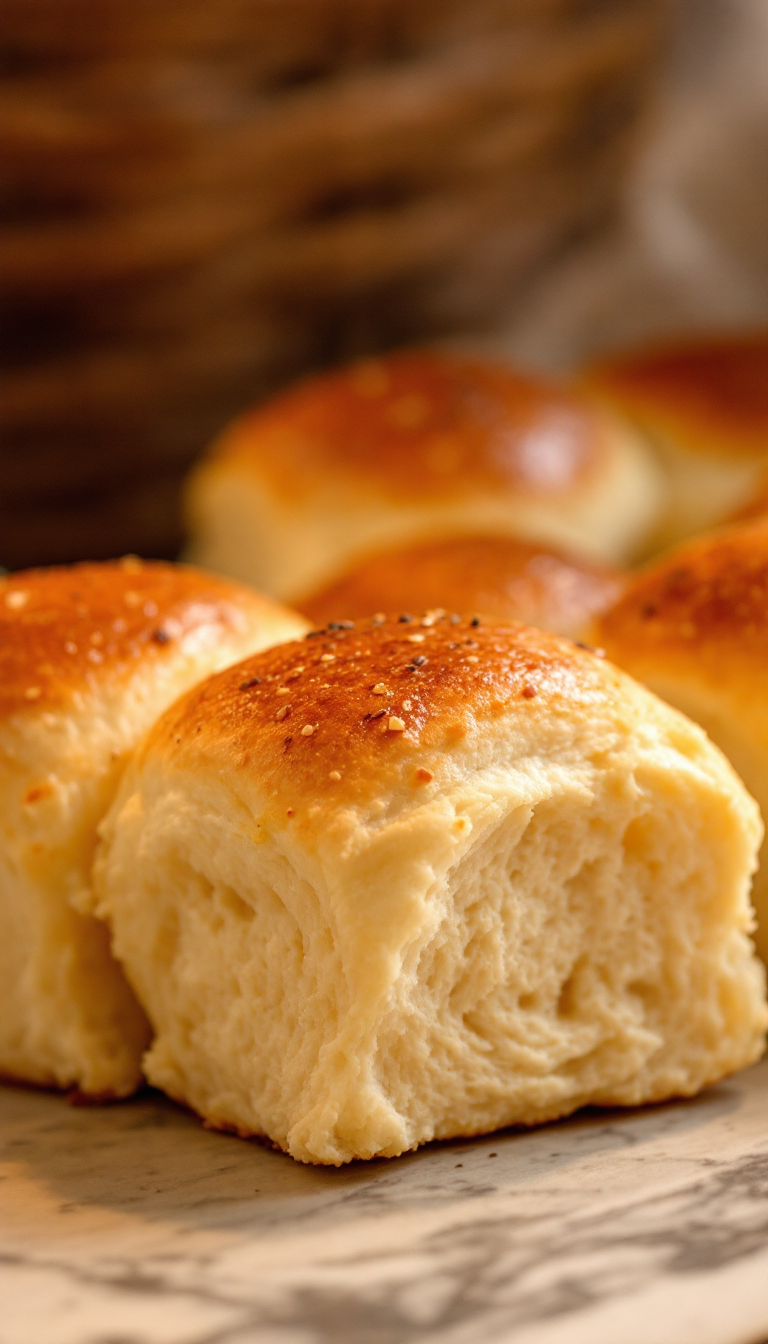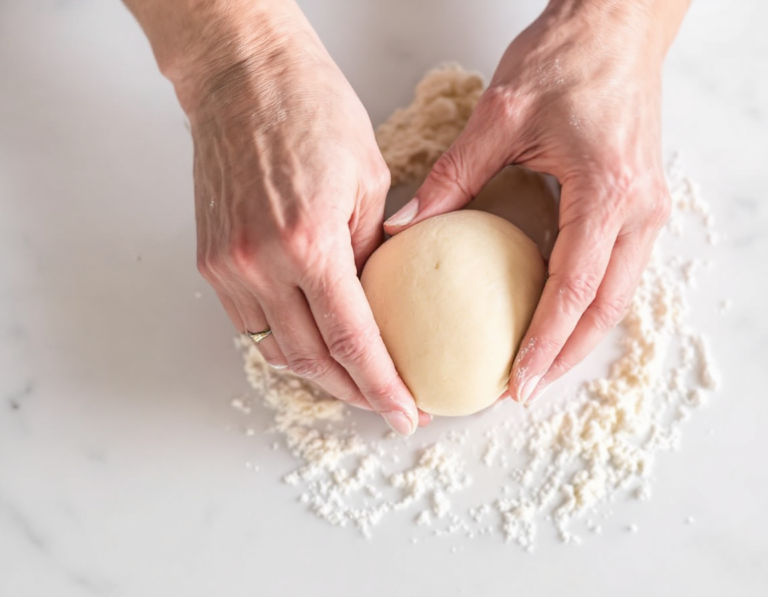There’s something almost magical about the aroma of freshly baked bread wafting through the kitchen. These gluten-free dinner rolls, soft as a cloud and as comforting as a warm hug on a chilly day, are perfect for everyone to enjoy. I remember the first time I made them—my family couldn’t believe they were gluten-free!
Steps
- In a stand mixer bowl, combine the gluten free flour, xanthan gum, tapioca starch, instant yeast, and sugar, then whisk them together. Add salt and whisk again to ensure everything is well-mixed.
- Pour the warm milk, melted butter, and egg whites into the dry ingredients. Use the paddle attachment to beat the mixture vigorously until it forms a clump that clears the bowl’s sides, then continue until it looks whipped and sticks to the bowl’s sides again, about 6 minutes.
- Transfer the dough to a lightly oiled container with a tight-fitting lid, allowing enough space for the dough to almost double. Let it sit at room temperature for at least 2 hours or refrigerate for up to 24 hours, ensuring not to exceed this time to avoid irregular rising.
- If refrigerated, bring the dough to room temperature before using. Grease a quarter sheet pan or multiple round cake pans, choosing whether to place rolls touching or apart, depending on your desired rise and shape.
- Divide the dough into 16 equal portions, each weighing about 2.5 ounces. Knead each piece in your hands, pinching any seams, then shape it into a round on a lightly floured surface.
- Arrange the shaped dough on the prepared pans, cover with greased plastic wrap, and let rise in a warm, draft-free area until they reach about 150% of their original size. This rising can take 45 minutes to several hours.
- Preheat your oven to 375°F as the rolls near the end of their rising phase. Once risen, remove the plastic wrap and generously brush the rolls with melted butter.
- Bake the rolls in the oven’s center until an instant-read thermometer shows an internal temperature of about 190°F. If rolls are touching, reduce the oven temperature to 350°F after 18 minutes and continue baking for about 5 more minutes.
- Once baked, remove the pan from the oven, brush the hot rolls with melted butter again, and serve immediately for the best taste and texture.
Ingredients
- free dinner rolls:
- 3 ¼ cups (455 g) all-purpose gluten-free flour blend
- 3 ¼ teaspoons xanthan gum (omit if your blend already contains it)
- ? cup (105 g) tapioca starch/flour, plus more for sprinkling
- 4 teaspoons (12 g) instant yeast
- ¼ cup (50 g) granulated sugar
- 1 teaspoon kosher salt
- 1 ? cups (13 fluid ounces) warm milk (about 90°F)
- 8 tablespoons (112 g) unsalted butter, melted and cooled (plus more for brushing)
- 2 (50 g) egg whites, at room temperature
Nutritional Values
Calories: 1808kcal | Carbohydrates: 544g | Protein: 48g | Fat: 112g | Saturated Fat: 64g | Polyunsaturated Fat: 3.2g | Monounsaturated Fat: 32g | Trans Fat: 3.2g | Cholesterol: 288mg | Sodium: 3136mg | Potassium: 1232mg | Fiber: 32g | Sugar: 64g | Vitamin A: 3440IU | Vitamin C: 0.16mg | Calcium: 528mg | Iron: 3.2mg
FAQ
- Why didn’t my gluten-free rolls rise?
- Several factors could prevent your gluten-free rolls from rising. Common issues include using too much flour, which changes the dough’s hydration and stops the yeast from working effectively, or not using enough sugar, which the yeast needs to feed on. Additionally, incorrect milk temperatures can inhibit yeast activation; milk that’s too cold slows the process, while milk that’s too hot can kill the yeast. Always ensure your yeast is fresh; if it doesn’t foam in warm water with sugar after 10 minutes, it might be expired.
- Why are my rolls dense?
- Dense gluten-free rolls often result from using too much flour. It’s crucial to measure your ingredients accurately, preferably using a kitchen scale rather than a measuring cup. Adding too much flour during shaping can also decrease dough hydration, which affects yeast activity and results in dense rolls.
- Can you freeze these rolls?
- Yes, freezing gluten-free rolls is an excellent time-saver. Follow the instructions for shaping and parbaking your rolls, then freeze them once completely cool. Before serving, let them defrost and then finish baking them in the oven until they’re fully cooked.
- What if I don’t have instant yeast?
- If you only have active dry yeast, you can substitute it by using 25% more than the instant yeast amount and dissolving it in some of the recipe’s milk before combining it with the rest of the ingredients. For this recipe, replace 12 grams of instant yeast with 15 grams of active dry yeast.
- Can gluten-free flour really be used to make yeasted rolls?
- Absolutely, gluten-free flour can be used for yeasted rolls. The key is precise ingredient measurement and using the specific gluten-free flour blend recommended in the recipe, ensuring the dough rises properly.
Tips
- Measure Ingredients Precisely: Use a kitchen scale to measure your gluten-free flour and other ingredients accurately. This ensures the dough has the correct hydration level, which is crucial for the rolls to rise properly and maintain the desired texture.
- Use the Right Equipment: A stand mixer is essential for achieving a smooth dough necessary for fluffy and squishy rolls. If you don’t have one, a food processor with a steel blade can be a substitute, but avoid using a hand mixer or mixing by hand.
- Optimal Rising Environment: Allow the dough to rise in a warm, draft-free area, ideally around 78°F. Avoid overly hot environments as they can kill the yeast, preventing the dough from rising.
- Eat Fresh and Store Correctly: These rolls are best enjoyed fresh from the oven. If you have leftovers, store them in an airtight container at room temperature for up to two days, and refresh them in the microwave or toaster oven before serving.
Equipment
- free dinner rolls, particularly items that may not be commonly found in every household:
- Stand Mixer – Essential for mixing the dough properly to achieve the desired texture.
- Kitchen Scale – Important for precise measurement of ingredients, especially gluten-free flour.
- Instant-Read Thermometer – Useful for checking the internal temperature of the rolls to ensure they are properly cooked.


